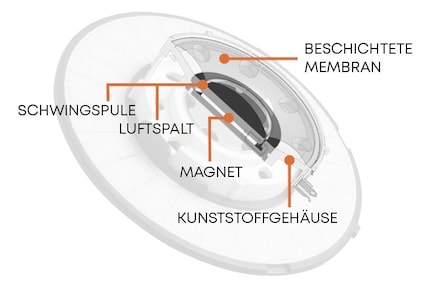

The effect of impedance on headphones
A pair of headphones with 32 ohms sounds louder than one with 250 ohms. But just how big is the difference? And do the headphones sound any different? I’m finding out just that.
Headphones can have very different impedances, the most common values being between 16 and 600 ohms. But what does this parameter mean and what effect does it have?
Impedance, or resistance, mainly influences the volume. A pair of headphones with 100 ohms will sound louder than one with 32 ohms. On mobile devices, this can become a problem. Simply put, the built-in amplifier of a smartphone doesn’t have the muscle to make high-impedance headphones sound really loud. If you want to use them connected to a weak source, you’ll need to plug them into a headphone amplifier. While there are lightweight, portable headphone amplifiers, it’s a cumbersome affair and brings about additional costs.
High-impedance headphones must also have an advantage, though, or there’d be no reason to manufacture them. Their advantage lies in more precise sound reproduction – at least in theory. Coiled copper wires make the diaphragm of the headphone speakers vibrate. The thinner these wires, the faster and more precisely the electrical signal can be converted into sound. However, thin wires mean a higher resistance. Picture a narrow water pipe – to get the same amount of water through it as through a wider pipe, a higher pressure is required.

Source: beyerdynamic.de
Just one factor of many
All that being said, not all headphones with a given resistance sound equally loud. It depends on the model in question and how it’s constructed, so the ohm value alone can’t tell you how loud a pair of headphones is; sensitivity is what it really comes down to. It’s expressed in dB or, to be exact, decibels of sound pressure level per millivolts (dB SPL/mV).
In terms of sound quality, it’s all the more true that impedance alone doesn’t tell you anything. There are a multitude of other factors that contribute to the sound pattern.
The only way you can draw any conclusions is by comparing two sets of headphones that are identical in all ways but impedance.
Almost triplets
The Beyerdynamic DT 770 Pro series makes testing this possible. It comes in three versions: with 32, 80 or 250 ohms. I compared them with each other to determine the differences in volume and sound.
On closer inspection, the build of these three headphones isn’t quite identical after all. All three have different cables, and the 32-ohm model also uses a different material on the ear pads. Another significant difference is that the 80-ohm version has an overhanging coil while the other two have a suspended coil. According to Beyerdynamic this affects the sound; the 80-ohm model is supposed to have less brilliance and a somewhat less pronounced bass range.
So far, so theoretical. Now, let’s put it into practice.
Volume comparison: listen for yourself
Let’s start with the simpler test: volume. The difference in volume is immediately noticeable, but less glaring than the difference in ohms suggests. I can listen to music on my smartphone with the 250-ohm headphones perfectly fine, just not too loudly. With the volume turned up to max, it’s just about loud enough. On my laptop, I experienced no limitations due to the high resistance.
The 80-ohm model is quite loud hooked up to my smartphone on maximum, but still pain-free. I’d say these headphones might only truly be too quiet when listening to low-volume audio, for example a conversation you recorded on your phone. The 32-ohm version leaves nothing to be desired in terms of volume – you can turn it up so that it really hammers into your eardrum.
Using our homemade binaural microphone, I recorded the same piece at the same volume on all three headphones. Here’s the comparison.
Sound comparison: the differences are minimal
The 80-ohm version of the DTP 770 Pro has a slightly different sound than the 32-ohm and 250-ohm models. However, this difference has nothing to do with the impedance, but the aforementioned coil construction.
The 80-ohm version is a bit less heavy on the treble with more emphasis on the mids – the lower mids, to be precise. Since the highs are almost too crisp for me on the 32- and 250-ohm models, I find the 80-ohm headphones to be more pleasant. They certainly don’t sound dull. Either way, the differences aren’t big – you need good headphones to hear them in the video.
This video doesn’t show you how these headphones sound in real life; the sound you hear depends mostly on your headphones and the microphone. The purpose here is just to showcase audible differences.
The 32 and 250-ohm versions sound very similar. The highs are sometimes a bit clearer at 250 ohms and percussive basses are a bit more defined and dry. The 32-ohm headphones may rumble, which indicates that the diaphragm can’t be made to vibrate and stopped again fast enough. Our homemade binaural microphone doesn’t pick up this subtle difference, though, probably because its bass sensitivity is too low.
Verdict – and my recommendation
When it comes to sound, impedance plays only a minor role. I have to listen very carefully to hear any difference between the Beyerdynamic DT 770 Pro with 32 ohms and the same model with 250 ohms. The 80-ohm model clearly sounds different, but isn’t directly comparable with the others because of its somewhat different construction. This difference in design is more important than impedance.
In terms of volume, the 32-ohm version comes in first place, as expected. It’s the only model to definitely offer enough oomph on a mobile device. But this isn’t really much of an advantage nowadays. The DT 770 Pro dates back to the 80s. There are better alternatives for smartphones today, namely wireless, space-saving headphones with active noise cancellation and a built-in microphone for making calls. The sound quality of Bluetooth has improved enormously, and many smartphones no longer even have a headphone jack.
That’s why I recommend having two sets of headphones: a small or foldable pair for on the go, with all the fancy modern features, as well as an old-school pair like the DT 770 Pro for at-home or studio use, or wherever else the highest sound quality outranks all other concerns. In this scenario, you don’t need to compromise and go for 32 ohms. Instead, choose a medium to high impedance. In the case of the DT 770 Pro, 250 ohms is best if you want maximum clarity and brilliance, while 80 ohms are recommended if you want the most pleasant sound pattern.
My interest in IT and writing landed me in tech journalism early on (2000). I want to know how we can use technology without being used. Outside of the office, I’m a keen musician who makes up for lacking talent with excessive enthusiasm.
Practical solutions for everyday problems with technology, household hacks and much more.
Show all



